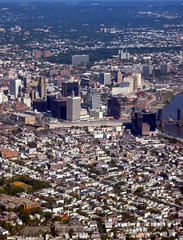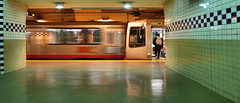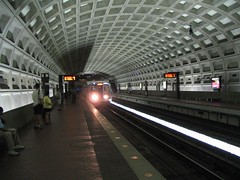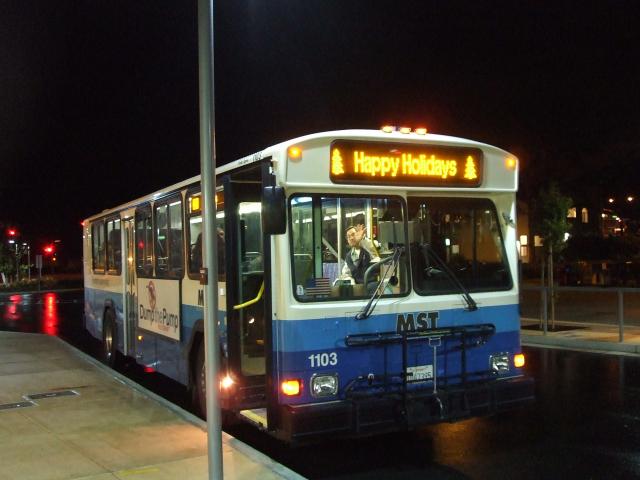A “Living on Earth” Interview with Bill Millar, President of the American Public Transportation Association
(Source: Living on Earth)
Ridership on the nation’s mass transit systems; subways, buses and light rails, is at an all time high. But while the mass is up – transit, the number of stops and services is dropping dramatically, even while ticket prices are taking a hike. The federal stimulus package will infuse a massive 16 billion dollars into public transit, half of that for high speed rails.
And William Millar, President of the American Public Transportation Association says, the money is arriving right on time.
MILLAR: Well we like to say it’s the best of times and worst of times, as that famous writer once said. In – since that – in 2007 we had reached a modern high of about 10.3 billion times that year Americans used public transit, only to be eclipsed in 2008. Looks like there’ll be at least five percent higher than that .
Eleven federally designated high-speed rail corridors have been in the works for years, but funding for the projects was not available until now. (Courtesy of the U.S. House of Representatives)
MILLAR: In most cases the revenue is not able to keep up with the cost. While people think of paying their fare let’s say when they get on the subway line, that fare is designed to only cover perhaps a third, maybe half the cost of the system. The rest comes from a combination of federal, state and local funds, and those funds come from the very sources that we’re seeing the down turn in the economy. So, sales taxes is a frequent way that it happens or property taxes, and, of course, property values are falling throughout the country. Sometimes gasoline taxes, but, of course, we’re using less gasoline than we did. So at the very time we ought to be increasing our public transit use to meet the new demand, we’re finding that many transit systems around the country are having to cut back, having to raise fares, because, of course, we have to balance our budgets just like everyone e/lse does.







 Of the 36 daily deaths on South Africa’s roads, an average of three are killed in taxi-related incidents – translating into 1 095 deaths every year. And according to a study by the Automobile Association of South Africa, around 70 000 minibus taxi crashes happen each year – double the number of accidents involving other motor vehicles.
Of the 36 daily deaths on South Africa’s roads, an average of three are killed in taxi-related incidents – translating into 1 095 deaths every year. And according to a study by the Automobile Association of South Africa, around 70 000 minibus taxi crashes happen each year – double the number of accidents involving other motor vehicles.
 The South African National Taxi Council (Santaco) wants to “reopen” the taxi industry in place of the bus-rapid transit (BRT) system, SABC radio news reported on Thursday. This formed part of a counter-proposal to the establishment of the BRT system.
The South African National Taxi Council (Santaco) wants to “reopen” the taxi industry in place of the bus-rapid transit (BRT) system, SABC radio news reported on Thursday. This formed part of a counter-proposal to the establishment of the BRT system.
 Taxi bosses say the government must shoulder the blame for the recent violent taxi strikes which led to the death of Katrina Samuels and her prematurely born baby, and the emotional and physical scarring of at least one other woman. Three weeks ago, the National Taxi Alliance (NTA) called for its members to stage a three-day strike in opposition to the Bus Rapid Transit System.
Taxi bosses say the government must shoulder the blame for the recent violent taxi strikes which led to the death of Katrina Samuels and her prematurely born baby, and the emotional and physical scarring of at least one other woman. Three weeks ago, the National Taxi Alliance (NTA) called for its members to stage a three-day strike in opposition to the Bus Rapid Transit System.
 Investment in transport-related infrastructure projects will total R50,9-billion over the next three years, reports the Treasury in its 2009 Budget Review. The South African Rail Commuter Corporation will receive an additional R600-million over the medium term in order to overhaul and upgrade 1 900 coaches and improve the signalling system.
Investment in transport-related infrastructure projects will total R50,9-billion over the next three years, reports the Treasury in its 2009 Budget Review. The South African Rail Commuter Corporation will receive an additional R600-million over the medium term in order to overhaul and upgrade 1 900 coaches and improve the signalling system.
 Investment in transport-related infrastructure projects will total R50,9-billion over the next three years, reports the Treasury in its 2009 Budget Review. The South African Rail Commuter Corporation will receive an additional R600-million over the medium term in order to overhaul and upgrade 1 900 coaches and improve the signalling system.
Investment in transport-related infrastructure projects will total R50,9-billion over the next three years, reports the Treasury in its 2009 Budget Review. The South African Rail Commuter Corporation will receive an additional R600-million over the medium term in order to overhaul and upgrade 1 900 coaches and improve the signalling system.
 The Gauteng provincial government (GPG) would spend about R40-billion in infrastructural projects over the next three years, in a move that could help to mitigate the impact of the global economic slowdown on the province, Gauteng Finance and Economic Development MEC Mandla Nkomfe said on Tuesday.
The Gauteng provincial government (GPG) would spend about R40-billion in infrastructural projects over the next three years, in a move that could help to mitigate the impact of the global economic slowdown on the province, Gauteng Finance and Economic Development MEC Mandla Nkomfe said on Tuesday.
 Intelligent Transport System (ITS) will be introduced on the entire Outer Ring Road (ORR) with Japanese assistance to facilitate smooth flow of traffic. Work on laying an eight-lane, accesscontrolled expressway (ORR), running to a total length of 158 km, around the Hyderabad city is in progress.
Intelligent Transport System (ITS) will be introduced on the entire Outer Ring Road (ORR) with Japanese assistance to facilitate smooth flow of traffic. Work on laying an eight-lane, accesscontrolled expressway (ORR), running to a total length of 158 km, around the Hyderabad city is in progress.




